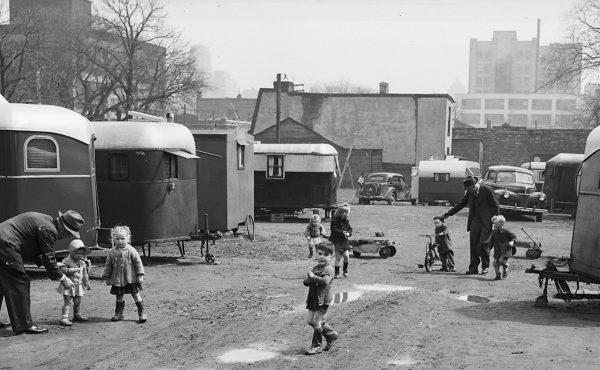
It has always bugged me that energy conservation programs are almost exclusively targeted at the relatively well-to-do, who need the help the least. Well, for 270 lucky low-income Toronto households, that is about to change. And with a little effort, we could be fixing up all of the poorly insulated, low-income homes in the city as part of Toronto’s climate change plan in order to cut back on both greenhouse gases and the energy bills of those least able to afford to heat the great outdoors.
Anyone who’s tried to run an environmental program knows that the coveted ‘early adopters’ (those who are cheapest and easiest to reach) tend to be mostly white, university-educated, middle- to upper-income, and native English speakers. This is, of course, the same group that is mostly likely to vote, and hence foremost in the minds of politicians. But it’s not who’s most in need of help, or where you get the biggest greenhouse gas savings.
Programs like the old federal Energuide for Houses program give middle-class home owners a rebate for making their homes more energy efficient. When the Harper government canned the program last year, they soon discovered that it was much-loved and have resurrected it with a new name.
Lost in the fuss was the cancellation of the brand new, $500 million Energuide for Low-Income Homes, which had been won by groups like Green Communities Canada and the Low-Income Energy Network as part of the Layton-Martin budget deal in the last minority Parliament and would have reached the (usually older and poorly maintained) houses and apartment buildings that really need it.
That bit of federal environmental backsliding should be neither forgotten nor forgiven, but picking up some of the slack is a new pilot program from the Ontario Power Authority. It is free and open to both renters and owners, although you have to be paying your electricity bill and you should have electric heat. I should confess that the OPA did ask me for my thoughts on how to do this, and my only complaint is that they should go faster and get the gas and oil companies involved as well.
The non-profit group Green$aver will be delivering it in Toronto. One of their principal challenges will be connecting with low-income households so if you think you’re eligible or work with people who are, give them a call at 416-203-3106.
I’m hoping it’ll be oversubscribed in no time, and then we can bang down the doors to make it a key part of Canada’s (and Toronto’s) climate plans.
photo by Bouke Salverda




6 comments
From the OPA site: “The pilot program, targeting as many as 1,400 private single, semi-detached and row houses…”
Still no help for low-income folks in apartments.
Luckily, I don’t pay my electric bill, but with baseboard heaters and massively drafty windows on the 23rd floor, I know my unit is a horrible energy hog.
There needs to be a serious, well-funded high rise retrofit program to push landlords on energy efficiency. Instead, there’s just more talk of sub-metering to push costs onto individual residents who have no control over major appliances and terrible windows…
Not intentionally, I guess, but the beautiful photo running with this post misleads as to the scope and nature of the OPA program.
How to deal with the tens of thousands of thermals slums that many of us rent? What if all utility bills for rentals were split between owners and renters – it’d be tricky to arrange in some instances, but both parties would have an interest in short and longer term energy conservation.
I’m in the same situation as Greg. And during some wall repairs, I got to see my building’s insulation: it’s white styrofoam, exactly like the stuff they ship electronics in. It does a terrible job.
For whatever reason, landlords aren’t upgrading energy efficiency even when they’re on the hook for huge electric bills. A similar program to give them a push could make a big difference.
Agreed, and they are working on a separate program for large apartment buildings (this one should cover the smaller walk-ups), but the retrofit work tends to be very different for the big towers. FYI, the Low Income Energy Network has done some excellent work on submetering
Not all home-owners in the city are wealthy. As a co-ownership co-op board member, I can attest to that. We’d just completed our first ever reserve fund study three years back and one of our big issues was how about half our ownership was going to be able to afford necessary building repairs _and_ energy conservation retrofits. After some research and legwork, we found CMHC’s Residential Rehabilitation Assistance Program. After further legwork, we found that that half our ownership would qualify for assistance on a couple of key projects. We were just starting to get everyone marshalled (in the Board’s copious spare time!) when the program was cancelled by the new tory government in September.
Well, set _that_ work program back a few years! It’s just going to take longer _and_ be more expensive, because otherwise, there’s a mess of seniors and marginal homeowners who’d be out on the street. Our building is about ten years older than the oldest city condos; our situation is why your legally mandated reserve fund contributions have increased.
We’re going to finance at least some of the energy retrofits (which are also part of building life cycle replacements) through a utlities loan program where they finance the retrofit and you pay for it out of the savings on your bills. Still a long and expensive process. Necessary, though.
What I really need is a source of wall insulation that will work without vapour barriers and that can be added to unit walls as they are renovated. Oh, and a complete rework of our hot water radiator system to allow for better zone distribution and control. Our older building doesn’t have them in the masonry walls, which makes increasing the R-value kind of tricky. We’re resisting adding stucco and external insulation because our brick work is in relatively good shape.